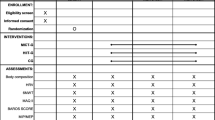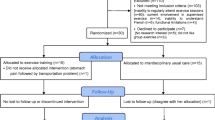Abstract
Objective
Laparoscopic sleeve gastrectomy (LSG) has demonstrated high long-term effectiveness and major advantages over other techniques. The objective of this study was to analyze changes in physical fitness parameters in morbidly obese patients during 6 months after LSG.
Methodology
We conducted a descriptive observational study with 6-month follow-up in 72 LSG patients, evaluating changes in body mass index (BMI), functional capacity (6-min walking test), hand grip strength (manual dynamometry), flexibility (fingertip-to-floor test), balance (Flamingo test), physical activity level (International Physical Activity Questionnaire, IPAQ), and perception of general physical fitness (International Fitness Scale [IFIS] questionnaire).
Results
The ANOVA revealed significant improvements in BMI, functional capacity, flexibility, balance, and physical activity level (P < 0.001) at 6 months, with an improvement in the perception of physical fitness in most cases. No significant changes were found in dominant hand (P = 0.676) or non-dominant hand (P = 0.222) dynamometry. General physical fitness was positively correlated with BMI and distance in the 6-min test, and was negatively correlated with fingertip-to-floor distance.
Conclusion
Morbidly obese patients showed major improvements at 6 months after LSG in functional capacity, balance, mobility, and physical activity, with no change in grip strength. These improvements were related to a better self-perception of general physical fitness.

Similar content being viewed by others
References
Buchwald H, Consensus Conference Panel. Bariatric surgery for morbid obesity: health implications for patients, health professionals, and third-party payers. J Am Coll Surg. 2005;200(4):593–604.
Gastrointestinal surgery for severe obesity. NIH Consens Statement 1991 Mar 25–27; 9(1):1–20.
Basterra-Gortari FJ, Beunza JJ, Bes-Rastrollo M, et al. Increasing trend in the prevalence of morbid obesity in Spain: from 1.8 to 6.1 per thousand in 14 years. Rev Esp Cardiol. 2011;64(5):424–6.
Ganz ML. The economic evaluation of obesity interventions: its time has come. Obes Res. 2003;11(11):1275–7.
Schirmer B. Laparoscopic bariactric surgery. Surg Endoc. 2006;20:S450–5.
Çetinkünar S, Erdem H, Aktimur R, et al. The effect of laparoscopic sleeve gastrectomy on morbid obesity and obesity-related comorbidities: a cohort study. Ulcus Cerrahi Derg. 2015;31(4):202–6.
Dixon JB, Zimmet P, Alberti KG, et al. Bariatric surgery: an IDF statement for obese type 2 diabetes. Diabet Med. 2011;28:628–42.
Sjöström L. Review of the key results from the Swedish Obese Subjects (SOS) trial—a prospective controlled intervention study of bariatric surgery. J Intern Med. 2013;273:219–34.
Cottam D, Qureshi FG, Mattar SG, et al. Laparoscopic sleeve gastrectomy as an initial weight-loss procedure for high-risk patients with morbid obesity. Surg Endosc. 2006;20(6):859–63.
Rosas V, Hines H, Rogan D, et al. The influence of resected gastric weight/weight loss after sleeve gastrectomy. Am Surg. 2015;81(12):1240–3.
Kral JG, Naslund E. Surgical treatment of obesity. Nat Clin Pract Endocrinol Metab. 2007;3:574–83.
Bult MJ, Van DT, Muller AF. Surgical treatment of obesity. Eur J Endocrinol. 2008;158:135–45.
Hutter MM, Schirmer BD, Jones DB, et al. First report from the American College of Surgeons Bariatric Surgery Center Network: laparoscopic sleeve gastrectomy has morbidity and effectiveness positioned between the band and the bypass. Ann Surg. 2011;254(3):410–20. discussion 420-2
ASMBS Clinical Issues Committee. Updated position statement on sleeve gastrectomy as a bariatric procedure. Surg Obes Relat Dis. 2012;8(3):e21–6.
Parikh M, Issa R, McCrillis A, et al. Surgical strategies that may decrease leak after laparoscopic sleeve gastrectomy: a systematic review and meta-analysis of 9991 cases. Ann Surg. 2013;257:231–7.
Casella G, Soricelli E, Rizzello M, et al. Nonsurgical treatment of staple line leaks after laparoscopic sleeve gastrectomy. Obes Surg. 2009;19(7):821–6.
Dapri G, Cadière GB, Himpens J. Reinforcing the staple line during laparoscopic sleeve gastrectomy: prospective randomized clinical study comparing three different techniques. Obes Surg. 2010;20:462–7.
Updegraff TA, Neufeld NJ. Protein, iron, and folate status of patients prior to and following surgery for morbid obesity. J Am Diet Assoc. 1981;78(2):135–40.
Raymond JL, Schipke CA, Becker JM, et al. Changes in body composition and dietary intake after gastric partitioning for morbid obesity. Surgery. 1986;99(1):15–9.
Mathus-Vliegen EM, Obesity Management Task Force of the European Association for the Study of Obesity. Prevalence, pathophysiology, health consequences and treatment options of obesity in the elderly: a guideline. Obes Facts. 2012;5:460–83.
Maniscalco M, Zedda A, Giardiello C, et al. Effect of bariatric surgery on the six-minute walk test in severe uncomplicated obesity. Obes Surg. 2006;16(7):836–41.
de Souza SA, Faintuch J, Fabris SM, et al. Six-minute walk test: functional capacity of severely obese before and after bariatric surgery. SurgObesRelat Dis. 2009;5(5):540–3.
Otto M, Kautt S, Kremer M, et al. Handgrip strength as a predictor for post bariatric body composition. Obes Surg. 2014;24(12):2082–8.
Katzmarzyk PT, Church TS, Janssen I, et al. Metabolic syndrome, obesity, and mortality: impact of cardiorespiratory fitness. Diabetes Care. 2005;28(2):391–7.
King WC, Belle SH, Eid GM, et al. Physical activity levels of patients undergoing bariatric surgery in the Longitudinal Assessment of Bariatric Surgery study. Surg Obes Relat Dis. 2008;4(6):721–8.
Stegen S, Derave W, Calders P, et al. Physical fitness in morbidly obese patients: effect of gastric bypass surgery and exercise training. Obes Surg. 2011;21(1):61–70.
Pietiläinen KH, Kaprio J, Borg P, et al. Physical inactivity and obesity: a vicious circle. Obesity (Silver Spring). 2008;16(2):409–14.
Laskin JJ, Bundy S, Marron H, et al. Using a treadmill for the 6-minute walk test: reliability and validity. J Cardiopulm Rehabil Prev. 2007;27(6):407–10.
Ruiz-Ruiz J, Mesa JL, Gutiérrez A, et al. Hand size influences optimal grip span in women but not in men. J Hand Surg Am. 2002;27(5):897–901.
España-Romero V, Ortega FB, Vicente-Rodriguez G, et al. Elbow position affects handgrips strength in adolescents: validity and reliability of Jamar, DynEX, and TKK dynamometers. J Strenght Cond Res. 2010;24:272–7.
Perret C, Poiraudeau S, Fermanian J, et al. Validity, reliability, and responsiveness of the fingertip-to-floor test. Arch Phys MedRehabil. 2001 Nov;82(11):1566–70.
Rodriguez FA, Gusi N, Valenzuela A, et al. Evaluation of health-related fitness in adults (I): background and protocols of the AFISICAL-INECFC battery. Apunts Educacion Física y Deportes. 1998;52:54–72.
Craig CL, Marshall AL, Sjöström M, et al. International physical activity questionnaire: 12-country reliability and validity. Med Sci Sports Exerc. 2003;35:1381–95.
Roman-Viñas B, Serra-Majem L, Hagströmer M, et al. International physical activity questionnaire: reliability and validity in a Spanish population. Eur J Sport Sci. 2010;10(5):297–304.
Ortega FB, Ruiz JR, España-Romero V, et al. The International Fitness Scale (IFIS): usefulness of self-reported fitness in youth. Int J Epidemiol. 2011;40(3):701–11.
Ortega FB, Sánchez-López M, Solera-Martínez M, et al. Self-reported and measured cardiorespiratory fitness similarly predict cardiovascular disease risk in young adults. Scand J Med Sci Sports. 2013;23(6):749–57.
Chetta A, Zanini A, Pisi G, et al. Reference values for the 6-min walk test in healthy subjects 20-50 years old. Respir Med. 2006;100(9):1573–8.
Tveter AT, Dagfinrud H, Moseng T, et al. Health-related physical fitness measures: reference values and reference equations for use in clinical practice. Arch Phys Med Rehabil. 2014;95(7):1366–73.
Gusi N, Prieto J, Madruga M, et al. Health-related quality of life and fitness of the caregiver of patient with dementia. Med Sci Sports Exerc. 2009;41(6):1182–7.
Wise RA, Brown CD. Minimal clinically important differences in the six-minute walk test and the incremental shuttle walking test. COPD. 2005;2(1):125–9.
Hansen N, Hardin E, Bates C, et al. Preoperative change in 6-minute walk distance correlates with early weight loss after sleeve gastrectomy. JSLS. 2014:18(3).
Rebibo L, Verhaeghe P, Tasseel-Ponche S, et al. Does sleeve gastrectomy improve the gait parameters of obese patients? Surg Obes Relat Dis. 2016.
Vargas CB, Picolli F, Dani C, et al. Functioning of obese individuals in pre- and postoperative periods of bariatric surgery. Obes Surg. 2013;23(10):1590–5.
Josbeno DA, Jakicic JM, Hergenroeder A, et al. Physical activity and physical function changes in obese individuals after gastric bypass surgery. Surg Obes Relat Dis. 2010;6(4):361–6.
Hue O, Berrigan F, Simoneau M, et al. Muscle force and force control after weight loss in obese and morbidly obese men. ObesSurg. 2008;18(9):1112–8.
Wadström C, Backman L, Forsberg AM, et al. Body composition and muscle constituents during weight loss: studies in obese patients following gastroplasty. Obes Surg. 2000;10(3):203–13.
Coupaye M, Rivière P, Breuil MC, et al. Comparison of nutritional status during the first year after sleeve gastrectomy and Roux-en-Y gastric bypass. Obes Surg. 2014;24(2):276–83.
Leong DP, Teo KK, Rangarajan S, et al. Prognostic value of grip strength: findings from the Prospective Urban Rural Epidemiology (PURE) study. Lancet. 2015;386(9990):266–73.
Heikkilä S, Viitanen JV, Kautiainen H, et al. Sensitivity to change of mobility tests; effect of short term intensive physiotherapy and exercise on spinal, hip, and shoulder measurements in spondyloarthropathy. J Rheumatol. 2000;27(5):1251–6.
Wiklund M, Olsén MF, Torsten O, et al. Physical fitness and physical activity in Swedish women before and one year after roux-en-Y gastric bypass surgery. Open Obesity J. 2014;6:38–43.
Moliner-Urdiales D, Ruiz JR, Ortega FB, et al. Association of objectively assessed physical activity with total and central body fat in Spanish adolescents; the HELENA study. Int J Obes. 2009;33(10):1126–35.
Moliner-Urdiales D, Ortega FB, Vicente-Rodriguez G, et al. Association of physical activity with muscular strength and fat-free mass in adolescents: the HELENA study. Eur J Appl Physiol. 2010;109(6):1119–27.
Fonseca-Camacho DF, Hernández-Fonseca JM, González-Ruíz K, et al. A better self-perception of physical fitness is associated with lower prevalence of metabolic syndrome and its components among university students. Nutr Hosp. 2014;31(3):1254–63.
Evans RK, Bond DS, Wolfe LG, et al. Participation in 150 min/wk of moderate or higher intensity physical activity yields greater weight loss after gastric bypass surgery. Surg Obes Relat Dis. 2007;3(5):526–30.
Lee PH, Macfarlane DJ, Lam TH, et al. Validity of the International Physical Activity Questionnaire Short Form (IPAQ-SF): a systematic review. Int J Behav Nutr Phys Act. 2011;8:115.
Acknowledgments
We are grateful to all patients who accepted to participate in this study.
Author information
Authors and Affiliations
Corresponding author
Ethics declarations
Conflict of Interest
The authors declare that they have no conflicts of interest.
Ethical Approval
All procedures performed were in accordance with the ethical standards of the institutional research committee and with the 1964 Helsinki declaration and its later amendments.
Informed Consent
Informed consent was obtained from all individual participants included in the study.
Rights and permissions
About this article
Cite this article
Gallart-Aragón, T., Fernández-Lao, C., Castro-Martín, E. et al. Health-Related Fitness Improvements in Morbid Obese Patients After Laparoscopic Sleeve Gastrectomy: a Cohort Study. OBES SURG 27, 1182–1188 (2017). https://doi.org/10.1007/s11695-016-2427-2
Published:
Issue Date:
DOI: https://doi.org/10.1007/s11695-016-2427-2




